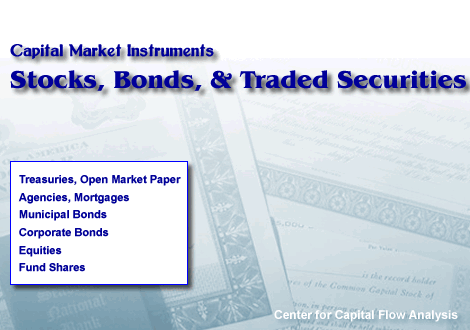Capital Flows for Stocks, Bonds, and Traded Securities
Stocks, Bonds, and Traded Securities

Flow of Funds Accounts For Traded Securities
The U.S. capital market is composed of six broad securities trading markets that are described in nine national flow of funds accounts, published quarterly by the Federal Reserve Bank.
Each market attracts different players with different goals.
Issuers in these major markets attract different classes of investors and are responsbile for over $53 trillion in securities outstanding (Q4 2004).
Each market has its own rules and sets of players.
For each of these securities markets, we publish color-coded flow of funds tables with definitions and links to related research resources.
Analysis of these flow tables is used to explain the forces of supply and demand that drive security prices.
Major Categories of Capital Market Instruments
The market value of issues outstanding in each of the six main securities markets in Q4 2004 was as follows:
| � | Market Instrument | $ trillion | % of total |
|---|---|---|---|
| 1 | Corporate Equities | 17.2 |
30.5% |
| 2 | Agency Securities & Mortgages | 16.7 |
29.7% |
| 3 | Fund Shares | 7.3 |
12.9% |
| 4 | Corporate Bonds | 7.2 |
12.8% |
| 5 | Treasuries and Open Market | 5.7 |
10.2% |
| 6 | Municipal Securities | 2.0 |
3.6% |
| � | Total Market Value of These Categories |
56.3 |
100.0% |
[There is some double counting here. For example, fund shares include portfolios of equities and bonds. Agency securities are often mortgages repackaged.]
The links, above, lead to a description of each instrument category, official Federal Reserve sector definitions, flow of funds and level tables, and off-site research resources.